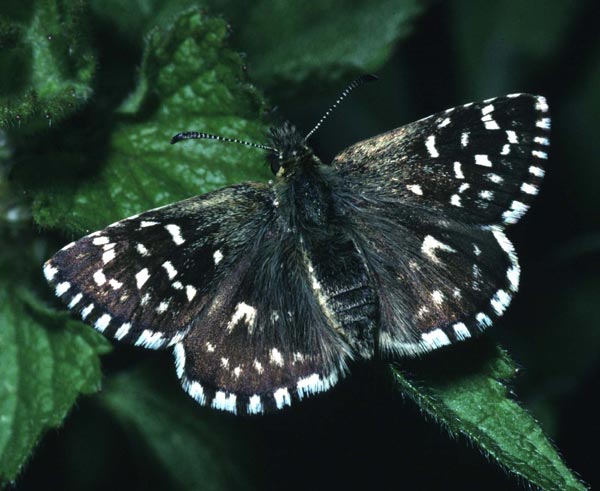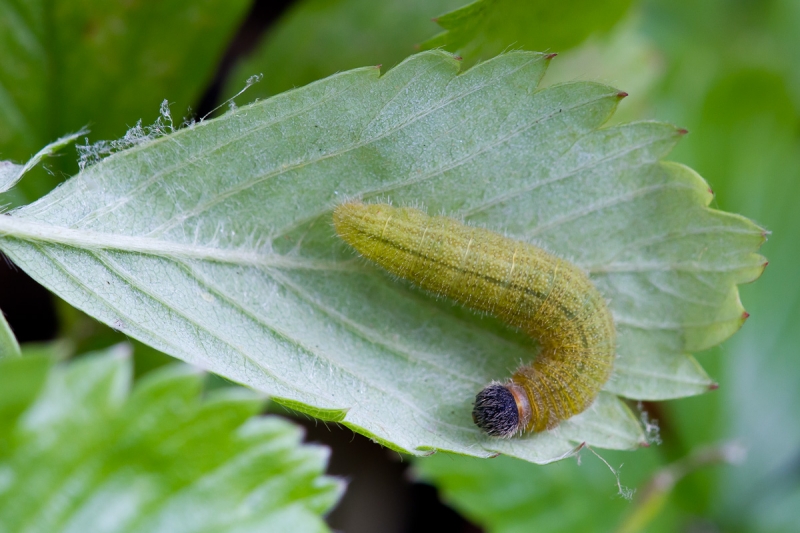Biodiversity
Related Links
Latest News
A Starring Role for Nantclwyd’s Lesser Horseshoe Bats
22.05.2015
Living Landscape Brought Back to Life
05.12.2014
Facebook Page
Grizzled skipper
This small butterfly has never been common in Wales but in recent years the species has sadly declined in both geographic range and population size.
 Description and identification: The grizzled skipper has a wing span of less than 3cm. It can be identified by the distinctive black (or dark brown) and white checked pattern on its wings. In flight it can be easily confused with a day-flying moth or the similar butterfly, the dingy skipper (which has a duller mottled wing pattern). The caterpillars are a pale greenish-brown with a darker head.
Description and identification: The grizzled skipper has a wing span of less than 3cm. It can be identified by the distinctive black (or dark brown) and white checked pattern on its wings. In flight it can be easily confused with a day-flying moth or the similar butterfly, the dingy skipper (which has a duller mottled wing pattern). The caterpillars are a pale greenish-brown with a darker head.
Habitat: The habitat of this butterfly includes woodland glades and rides, unimproved grassland and former industrial sites. In Denbighshire it favours unimproved grassland sites on limestone and woodland glades.
Diet: The adults feed on the nectar from species such as bird's-foot trefoil and buttercup. The larval food plants include a variety of plants in the rose family, such as wild strawberry, creeping cinquefoil and agrimony.
 Ecology and reproduction: The grizzled skipper lives in small colonies and prefers warm, sheltered areas. The adult butterflies fly from April to June. After mating, females lay eggs singly on the underside of the leaves of food plants in warm positions, such as near to bare ground or in short vegetation. Once hatched the caterpillars protect themselves by building “tents”, spinning together the edges of leaves. They over-winter as pupae within cocoons of leaves and silk, amongst low vegetation, emerging as adult butterflies in the spring. The adults are warmth-loving and bask in the sun. Males are territorial and will chase away other butterflies.
Ecology and reproduction: The grizzled skipper lives in small colonies and prefers warm, sheltered areas. The adult butterflies fly from April to June. After mating, females lay eggs singly on the underside of the leaves of food plants in warm positions, such as near to bare ground or in short vegetation. Once hatched the caterpillars protect themselves by building “tents”, spinning together the edges of leaves. They over-winter as pupae within cocoons of leaves and silk, amongst low vegetation, emerging as adult butterflies in the spring. The adults are warmth-loving and bask in the sun. Males are territorial and will chase away other butterflies.
Distribution: The grizzled skipper is found in parts of Europe and Asia. In Britain it is found in central and southern England and parts of Wales, including the north east. In Denbighshire this species is known from a handful of sites, including Loggerheads Country Park and Eyarth Rocks, Pwllglas.
Threats: The grizzled skipper is thought to have declined by at least 64% since 1980. This sharp decline has been mainly caused by loss and degradation of its habitat, due to changes in management of woodlands and grasslands, such as the lack of traditional coppicing and ride management in woodlands and inappropriate grazing and use of fertilizers in grasslands. Fragmentation of habitat is a problem, with patches of suitable habitat becoming increasingly isolated. Climate change may also be a factor.
Status: This butterfly has been assessed as being Vulnerable worldwide as listed on the Butterfly Red List and is a priority species for conservation action at a UK, Wales and Denbighshire level.



